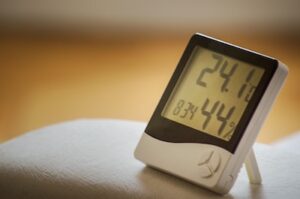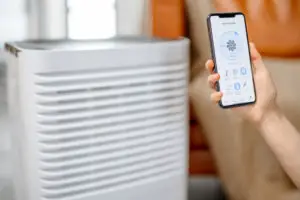Understanding Optimal Dehumidifier Settings
Living in a home with high humidity is uncomfortable and creates secondary issues with mold, dust mites, and other health problems. Luckily, a dehumidifier can help reduce the humidity levels in your home and protect you against such health problems. But what is the right humidity level? What level should you set your dehumidifier on? Let’s find out!
What setting should a dehumidifier be on? The best setting for a home dehumidifier is between 30 and 50%, though most people will find comfort at a 45% humidity level. There are challenges when there is too much humidity in the air, as well as when there is not enough humidity in the air. This range prevents dust mites from thriving and mold from growing in your home and keeps you from experiencing symptoms of dry air.
If you have bad allergies or have noticed a musty smell coming from your basement, chances are it’s because of the humidity in your home. Let’s explore why this is the case and talk about what kind of dehumidifier is best for you!

What is Humidity?
The term humidity refers to the amount of moisture in the air. As the temperature gets warmer, the amount of moisture the air can hold gets higher, so the hotter it gets, the more humid it gets. As temperatures decrease, the less humid it becomes.
If you live in the south, you likely know exactly how this feels as summers are often extremely hot and humid in the United States. When it comes to your home, this high humidity can have some very negative effects on both your health and your home.
Excess moisture can cause mold growth, dust mites, allergy problems, respiratory issues, and much more. Dehumidifiers work to reduce the amount of excess moisture in the air by collecting the water in a bucket over a few hours.
Depending on the levels of humidity in your home, you could be dumping these buckets several times a day until things even out. Removing excess moisture is an important step in maintaining the value of your home.
How Does a Dehumidifier Work?
Dehumidifiers draw water out of the air and into its coils through a fan. The warm air that comes in then contracts when it goes through the refrigerated coils, and condensation forms. Once the condensation collects, water droplet by water droplet, it sits in a storage tank or bucket connected to the dehumidifier. Cool air is then released back into your home through the dehumidifier.
As the storage bucket fills up, the dehumidifier will then shut off, letting you know that you need to empty the tank before it starts running again. Depending on the humidity levels in your home, you may need to empty the bucket several times a day until things start to even out.
Just as there are problems with too much humidity, there are also problems when there is not enough. Dry air can worsen illnesses like pneumonia, cause flare-ups for people with eczema, dehydration, and more.
The best way to prevent these problems is to simply monitor the humidity levels in your home. Both humidifiers and dehumidifiers serve great purposes – when they are used correctly. Depending on your environment, humidifiers are most useful in the winter and dehumidifiers are most useful in the spring/summer.
Choosing the Right Dehumidifier
Dehumidifiers come in every size and price range – from a small $100 dehumidifier to a large $1000+ dehumidifier, there’s plenty to choose from. When looking at your options, it’s important to keep your budget and needs in mind.
The best way to determine what size dehumidifier will work best for your home is to first check the humidity level. After you’ve determined the kind of strength you will need to pull the moisture out of the air, you can go to your local home/hardware store and talk to a professional. They will help you narrow your choices based on the size of the room, humidity levels, and your budget.
Choosing the Right Setting for Your Dehumidifier
Both the climate in which you live as well as the area of your home that suffers from high humidity levels will help determine the setting you should set your dehumidifier on. Some homes require just a regular store-bought dehumidifier for the basement, while others require full-home dehumidifiers.
You will know the areas of your home that will benefit most from a dehumidifier by musty smells, condensation on the windows, and damp spots on walls or ceilings. After you’ve determined the trouble areas, find out the humidity level in that room with a hygrometer you can find at any local retailer.
The humidity level will give you an idea of the ideal setting you should set your dehumidifier to, ideally it will be between 30-50%. Once you start emptying the storage bucket from your dehumidifier, you may be able to adjust the setting appropriately.
 Where Should You Put a Dehumidifier?
Where Should You Put a Dehumidifier?
Getting a dehumidifier is the first step, the next is to place it in the right spot and operate it correctly. More than likely, you will be placing your dehumidifier in a basement, laundry room, or bathroom, where moisture is likely to be present.
Within the room, a dehumidifier should be placed in a position where there is enough room for air to flow freely into and out of the dehumidifier. It will help the dehumidifier to work more effectively in an enclosed space – close windows and doors.
When operating a dehumidifier, you should be sure to maintain the machinery. This means emptying the bucket regularly is important, as well as cleaning the dehumidifier on a consistent basis. Though dehumidifiers are not extremely expensive, it is much more cost-effective to just take care of the one you have.
Other Ways to Deal With Dampness in the Home
Sometimes, even the best dehumidifiers are unable to get rid of all the excess moisture in the air, so here are a few things you can do to help!
- Check plumbing for leaks – leaks tend to escape our notice at times, so if you’re experiencing higher humidity than normal, you should always check the plumbing.
- Clear out your gutters – when gutters get cluttered, it can cause rainwater to settle near the house. If you clear them out, the rainwater will flow away from the home and help limit any more moisture collections.
- Run the exhaust fan – exhaust fans tend to be noisy, which means we don’t always like to use them, but you should. Exhaust fans draw water out of the bathroom when you shower, helping to clear out the excess moisture. This also prevents mold growth in the bathroom and clears the area quicker.
- Maintain a clean dryer duct – the dryer duct vents the warm exhaust air to the outside. When you clean the duct out, it allows the air to flow more freely – which also allows the laundry to dry faster and helps prevent dryer fires.
Related Questions
Should I Leave My Dehumidifier on All the Time?
It is not necessary to have your dehumidifier running all the time, only when the humidity levels are above 50%. If your home tends to be humid the majority of the time, it may be better to consider installing a dehumidifier that drains to the floor automatically.
There shouldn’t be any issues if you choose to have it running constantly, however you will have to empty the water constantly as well. You should only need to use a dehumidifier in the summer months, possibly throughout the day and into the night. If you are having to run it more often – there could be other problems that need to be addressed.
What Are the Disadvantages of Using a Dehumidifier?
Dehumidifiers can be loud, they use a lot of energy, and maintaining the machine can be a lot of work. Depending on the type of dehumidifier you purchase (expensive may mean less noise), these issues may become less of a problem. You’ll want to determine if the disadvantages outweigh the advantages though – mold, mildew, must smell, etc.
Going back to whether you should run a dehumidifier all the time, the answer is probably not unless you want to be paying a high electricity bill. Because you leave the machine plugged in all the time and it is constantly using energy to collect and expel the water, your energy bill will take a hit after continuous dehumidifier use.
The one major disadvantage to a dehumidifier is the continuous emptying of the water storage tank. Once it’s full, the dehumidifier will stop running until it gets emptied, which means more humidity will collect and the dehumidifier will still be needed. There’s not much you can do about this unless you install a dehumidifier that directly drains into the floor – which is extremely expensive.
